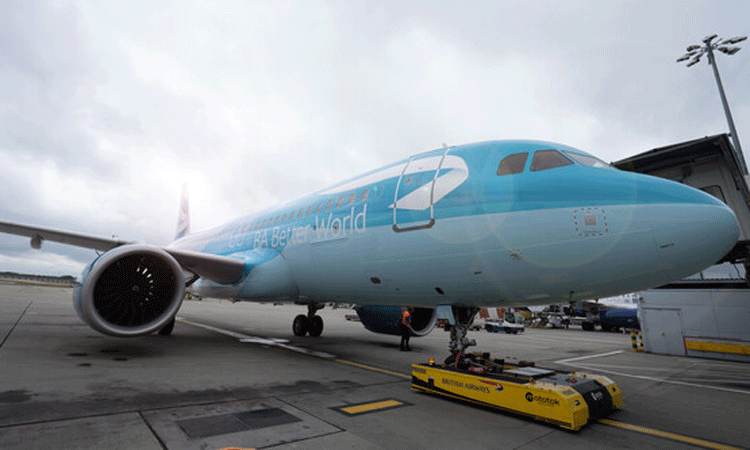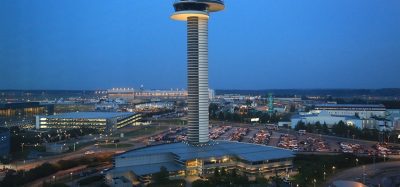Heathrow partners with British Airways to make net-zero flying a reality
- Like
- Digg
- Del
- Tumblr
- VKontakte
- Buffer
- Love This
- Odnoklassniki
- Meneame
- Blogger
- Amazon
- Yahoo Mail
- Gmail
- AOL
- Newsvine
- HackerNews
- Evernote
- MySpace
- Mail.ru
- Viadeo
- Line
- Comments
- Yummly
- SMS
- Viber
- Telegram
- Subscribe
- Skype
- Facebook Messenger
- Kakao
- LiveJournal
- Yammer
- Edgar
- Fintel
- Mix
- Instapaper
- Copy Link
Posted: 16 September 2021 | International Airport Review | No comments yet
London Heathrow has teamed up with British Airways, Airbus, BP, Glasgow Airport and NATS to pilot a net-zero short flight, powered by sustainable aviation fuel, from Heathrow to Glasgow Airport.


Credit: London Heathrow
Britain’s aviation industry has come together to operate a net-zero flight. The short flight, British Airways BA1476 from London Heathrow (LHR) to Glasgow Airport (GLA), was powered directly by sustainable aviation fuel (SAF), provided by BP, blended at 35 per cent with traditional jet fuel in accordance with technical aviation specifications. The remaining emissions produced by the flight were offset.
The aim of the flight was to show how far the aviation industry has progressed in its efforts to decarbonise over the last decade. Several factors within the journey were calibrated to achieve minimal emissions, from British Airways’ Airbus aircraft being pushed back by electric Mototok vehicles powered by Heathrow’s supply of 100 per cent renewable electricity, to flying on the most direct routing and optimal flight level.
On 14 September 2021, the flight was operated by an Airbus A320neo, the quietest and most fuel-efficient short-haul aircraft currently in British Airways’ fleet.
Air traffic controllers at NATS directed the aircraft on its continuous climb from Heathrow and descent into Glasgow, avoiding any levelling off, which causes an increase in fuel burn. The most direct routing was provided by NATS, as well as the most optimal flight level and the aircraft was able to land without airborne holding; techniques that successfully saved fuel and reduced emissions.
The flight achieved a 62 per cent CO2 emissions reduction compared to a decade ago – 34 per cent from efficient aircraft and operations, 28 per cent from the use of sustainable aviation fuel and the remaining 38 per cent offset using high quality, verified carbon offsets.
This move towards the ‘Perfect Flight’ showcases several solutions that can help to reduce emissions associated with flying. The industry can use sustainable fuels, reduce fuel consumption by using more efficient routes in the air, and utilise electric plug-in power while on the ground to make flights more sustainable. Airports can also follow Heathrow’s lead by offsetting remaining emissions, using natural solutions such as tree planting and peatland restoration to remove carbon.
SAF is a proven technology that can work across the world to decarbonise aviation. While the solutions exist, the UK government needs to urgently implement policies to scale up SAF, encourage the production of sustainable fuel and have the right price incentives for airlines to use it. This includes setting escalating mandates that requires a minimum of 10 per cent SAF use by airlines by 2030, which British Airways and its parent company IAG committed to recently, increasing to at least 50 per cent by 2050.
London Heathrow has been at the forefront of advocacy and change on reducing carbon emissions in the aviation sector. In addition to incorporating the first shipment of SAF into its fuel supply system back in June 2021, the major airport has been running on 100 per cent renewable electricity for almost five years, with ongoing plans to switch from gas heating by the mid-2030s, becoming fully zero carbon. 90 per cent of the airport’s cars and small vehicles are electric, with £7 million invested in electric charging points. Heathrow’s one of the best-connected airports in the country by public transport, with Crossrail soon connecting travellers through central London in addition to the tube and Heathrow Express.
“The Perfect Flight shows that the solutions to deliver net-zero flight exist, we just need to scale them up,” said John Holland-Kaye, Heathrow CEO. “The faster we scale up supply and use of sustainable aviation fuels, the faster we can decarbonise aviation and protect the benefits of flying in a world without carbon. What is needed urgently is for the government to introduce policies to increase the supply of SAF and to provide the right price incentives for airlines to use it.”
Sean Doyle, British Airways’ Chairman and CEO, commented: “This flight offered a practical demonstration of the progress we’re making in our carbon reduction journey. By working together with our industry partners we’ve delivered a 62 per cent improvement in emissions reductions compared to a decade ago. This marks real progress in our efforts to decarbonise and shows our determination to continue innovating, working with governments and the industry, and accelerating the adoption of new low carbon solutions to get us closer still to the ‘Perfect Flight’ of the future.
“With BA Better World, we’re making progress on our journey to a sustainable future and have adopted a range of short, medium and long-term initiatives to get us to net-zero emissions. Together, we can build a future for aviation that delivers the wonders of air travel while reducing the impact on the environment.”
Julie Kitcher, Airbus’ Executive Vice President Corporate Affairs and Communications added: “The A320neo is a great example of how far our industry has come. It meets all the ICAO environmental standards thanks to advances in engines, aerodynamics, cabin, and flight operations. The A320neo burns 20 per cent less fuel, which means less CO2, compared to its predecessor and is 50 per cent quieter.”
“We are honoured to join forces with British Airways on this important initiative,” said Martin Thomsen, BP Aviation Division CEO. “At BP we are focusing on working with hard-to-abate sectors, such as aviation, as part of our ambition to be net-zero by 2050 or sooner and to help the world get there too. By working collaboratively with industries, we can help to accelerate decarbonisation and we believe SAF will be one of the key solutions to fulfil this for the aviation sector.”
In response to the new partnerships, Derek Provan, Glasgow Airport CEO further commented: “This flight demonstrates the progress the industry has made during the last decade and how we can work collectively to decarbonise aviation. As one of the UK’s largest airport groups, we are committed to achieving net-zero by mid 2030s. This involves decarbonising our own infrastructure, including the roll out of fixed electrical ground power (FEGP), which is powered using 100 per cent renewable energy sources.”
“Live demonstrations like this show just what is possible and are an important step on the aviation industry’s path to net-zero by 2050,” said Martin Rolfe, NATS CEO. “We can learn a lot from flights like these, as they help us understand how to redesign the airspace over the UK and play our part in making flying sustainable for the future.”
Related topics
Aircraft, Airport development, Emissions, In-flight activity, Sustainability, Sustainable Aviation Fuel (SAF), Sustainable development
Related airports
Related airlines
Related organisations
Airbus, BP, International Civil Aviation Organisation (ICAO), National Air Traffic System (NATS)
Related regions
Related people
Derek Provan, John Holland-Kaye, Julie Kitcher, Martin Rolfe, Martin Thomsen, Sean Doyle


















